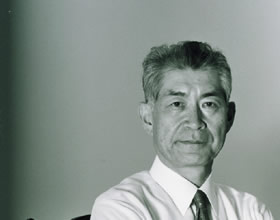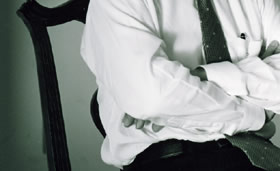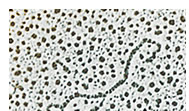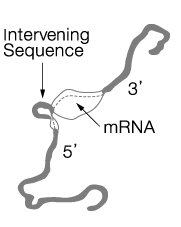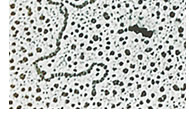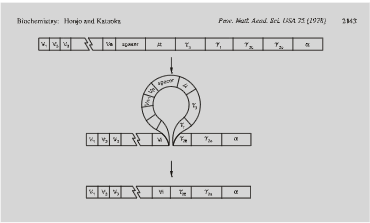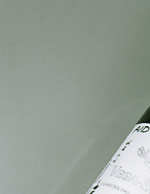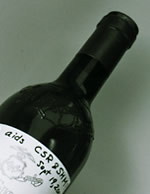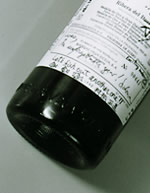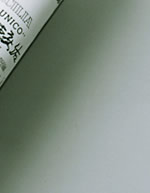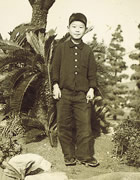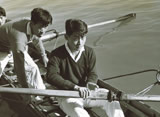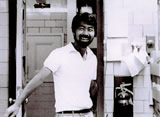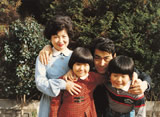 |
| My encounter with molecular biology |
 |
 |
While it was good to be filled with curiosity during my primary school days, I also could be a little devil. I never paid attention in class, but spent all my time thinking about playing. I finally buckled down to my studies in junior high school. When it came time to enter university, I thought I was unsuited to being used by others, and I couldn't make up my mind whether I wanted to be a doctor, lawyer, or diplomat. I thought I might be able to help a lot of people as a doctor, so I enrolled in the Faculty of Medicine at Kyoto University.
During my first year at university, I encountered molecular biology through the book, [The Revolution in Biology] by Dr. Atsuhiro. Shibatani. That was the dawn of the period when the DNA codon was being unraveled using bacteria from the colon. The book stated, "The day will soon come when DNA abnormalities can be corrected with a pair of tweezers as in surgery." Right away, I went to visit Dr. Shibatani, and he gave me a thick thesis to read. I didn't understand a word of it.
During my second year at university I was in and out of the lab of Dr. Osamu Hayaishi (Kyoto University professor emeritus). During my third year, I decided to make basic research my career. After starting the Ph.D. program, I began my career in research under the instruction of Dr. Yasutomi Nishizuka (former dean of Kobe University). |
 |
| My Encounter with Immunology |
 |
 |
I wanted to study the molecular biology of eukaryotic organisms, so I got the idea to study in the United States. My new teacher became Dr. Donald Brown (Carnegie Institute), who was conducting research into the ribosome genes of frogs.
During a seminar by Dr. Brown, I was inspired by the discussion of a theory regarding the diversity production mechanism of antibodies based on an analogy with the structure of ribosome genes. I began to study under Dr. Philip Rader, conducting research into the antibody genes of mice at NIH. I plunged headfirst into one of about 10 groups around the world at that time engaged in fierce competition to discover the molecular mechanism that created antibody diversity. Placing myself in intense competition when I was young also had an effect on my later research. |
 |
| The discovery of the class switch model |
 |
 |
I returned to Japan with the desire to do world-class research in Japan. The B lymphocyte that produce antibodies first make antibodies in the IgM class to very efficiently eliminate diverse antigens. They later produce antibodies of the IgE and IgA classes in response to the locations penetrated by antigens, such as blood and mucous membranes (intestines, trachea). The treatment after antigen combination differs with the class of antibody. I wanted to elucidate this mechanism for creating the differences of class, so I purified the mRNA of the antibodies, made cDNA, and measured the number of genes.
During my time at Tokyo University, I used the 90-minute commute by train to collate my data. One day, I noticed that the B cells produced an antibody depending on the other antibody class gene’s deletion. Part of the constant gene related to the treatment after antigen combination had been lost. I wondered if it had changed classes. I formulated a hypothesis of an H-chain genetic sequence order that would not be contradictory for this model. I was very excited. After I got home, I went through my notes to reconfirm that no data contradicted the model. No contradiction emerged.
I talked to everyone at the lab the next day, and right away we began to devise an experiment that would verify the model. That became the class switch model. I presented this model to the American Journal Academy in 1978. This received international acclaim, and it also was covered in the News & Views section of [Nature]. My joy was doubled. In the 20 years since then, I have determined the genetic structure, elucidated the details of the mechanism, and discovered the enzyme causing the class switch.
I persisted in following up a question that had arisen within me, and became aware of closely examining on the essence of the problem to be analyzed. I think that was the key to my success. Various biological principles are concentrated in immunity. I expect that we will learn as yet undiscovered biological principles, primarily in immunology. This will undoubtedly grow more interesting. Now, I am actively involved in applying my findings to treatment, and I have finally returned to my original point of departure during my youth of wanting to help people.
(Text: SICP sector) |
|
|
Upper: An electron microscope photo showing the combination of H-chain mRNA and cloned DNA, which shows the existence of intron
Lower: The model diagram for the composition of H-chain constant genes and the missing gene, from a thesis presented to the American Journal Academy in the United States in 1978.
|
|
|
A bottle of 1962 Vega-Sicilia, the highest-quality Spanish wine. I received a bottle when I discovered AID (Activation induced Cytidine Deaminase), the enzyme causing the class switch. Everyone signed and dated the label on the bottle, and it is on display in the teachers' room.
(photograph by Naruaki Onishi) |
|
 |
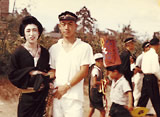 |
 As a high school student, with a friend participating in a costume procession during a sports festival As a high school student, with a friend participating in a costume procession during a sports festival
I sought many new challenges during my university days. |
 |
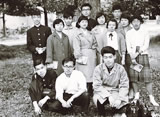 |
 The English Club. I am at the far right at front row. The English Club. I am at the far right at front row. |
 |
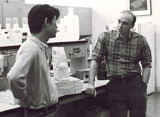 |
 In a discussion with Dr. Brown In a discussion with Dr. Brown |
 |
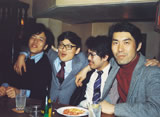 |
 With a lab member while presenting a model With a lab member while presenting a model
From left: Dr. Naoki Takahashi (Now at Nara Institute of Science and Technology), Dr. Toshiaki Kawakami (Now at La Jolla Institute), Dr. Akira Shimizu (Now at Kyoto University), and Tasuku Honjo. Dr. Toru Kataoka, also a member of the group, is unfortunately not shown because he probably took the photo.
|
 |
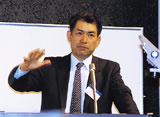 |
 Motto: Think of what the other person wants to know and tell them. Motto: Think of what the other person wants to know and tell them. |
 |
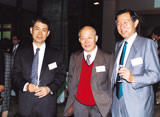 |
 At an academic society party with Dr. Nishizuka (center). On the right is Dr. Kumao Toyoshima At an academic society party with Dr. Nishizuka (center). On the right is Dr. Kumao Toyoshima |
 |
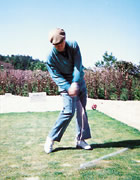 |
 I also play tennis, but like golf the best. I also play tennis, but like golf the best. |
 |
|
